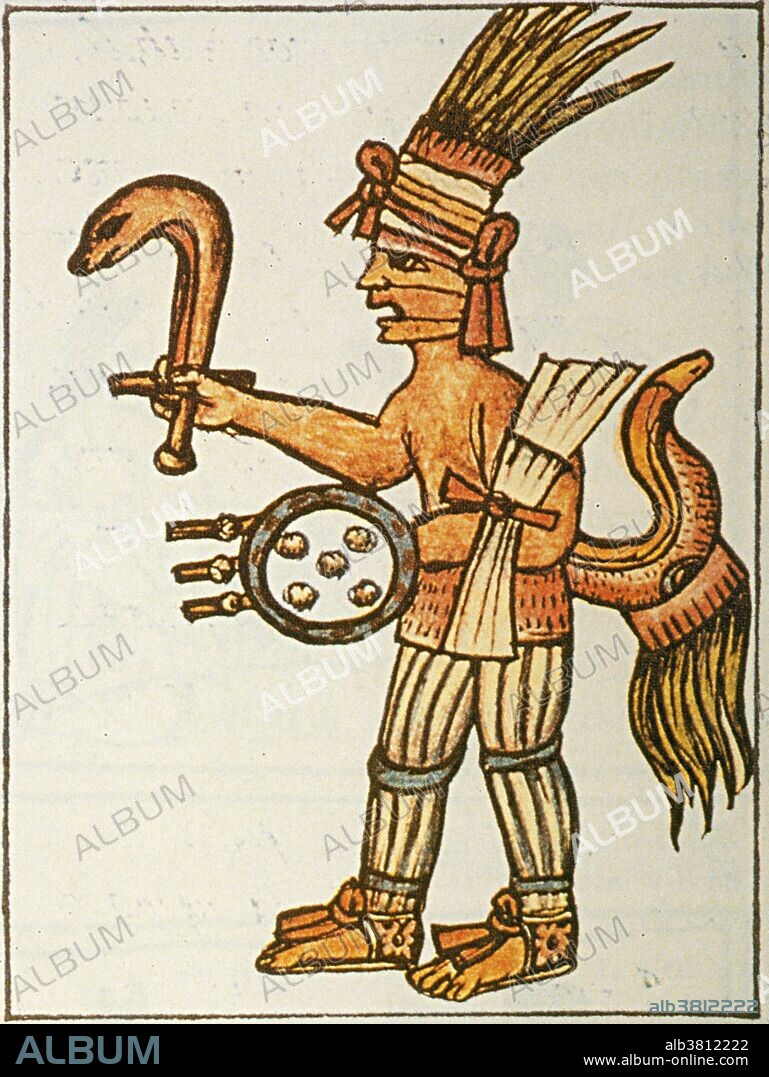alb3812222
Huitzilopochtli, Aztec God of War

|
Add to another lightbox |
|
Add to another lightbox |



Buy this image.
Select the use:

Title:
Huitzilopochtli, Aztec God of War
Caption:
Huitzilopochtli with fire serpent, from the Florentine Codex. In Aztec religion, Huitzilopochtli was a god of war, sun, human sacrifice and the patron of the city of Tenochtitlan. He was also the national god of the Mexicas of Tenochtitlan. Huitzilopochtli was a tribal god and a legendary wizard of the Aztecs. Originally he was of little importance to the Nahuas, but after the rise of the Aztecs, Tlacaelel reformed their religion and put Huitzilopochtli at the same level as Quetzalcoatl, Tlaloc, and Tezcatlipoca, making him a solar god. The Florentine Codex is the common name given to a 16th century ethnographic research project in Mesoamerica by Franciscan friar Bernardino de Sahagún. Bernardino originally titled it: La Historia General de las Cosas de Nueva Espana (The General History of the Things of New Spain). Bernardino conducted research, organized evidence, wrote and edited his findings starting in 1545 up until his death in 1590. It consists of 2400 pages organized into twelve books with over 2000 illustrations drawn by native Aztec artists.
Personalities:
Credit:
Album / Science Source / New York Public Library
Releases:
Model: No - Property: No
Rights questions?
Rights questions?
Image size:
2898 x 3859 px | 32.0 MB
Print size:
24.5 x 32.7 cm | 9.7 x 12.9 in (300 dpi)
Keywords:
16 16TH XVI XVITH SIXTEENTH CENTURY • 16 CENTURY • 16TH CENTURY • 16TH • ANCIENT CIVILIZATION • ANCIENT CULTURE • ART • ARTFORM: ICON • ARTWORK • AZTEC CIVILIZATION • AZTEC CODEX • AZTEC CODICES • AZTEC EMPIRE • AZTEC GOD • AZTEC PANTHEON • AZTEC RELIGION • AZTEC • BERNARDINO DE SAHAGUN • BERNARDINO DE SAHAGúN • CELEBRITIES • CELEBRITY • CENTRAL AMERICA • CODEX FLORENTINE • CODEX • CODICES • DEITY • DRAWING • ETHNOGRAPHIC RESEARCH • FAMOUS PEOPLE • FAMOUS • FIRE SERPENT • FLORENTINE CODEX • FRANSCICAN • FRIAR • GENERAL HISTORY OF THE THINGS OF NEW SPAIN • GOD OF HUMAN SACRIFICE • GOD OF SUN • GOD OF WAR • GOD • HISTORIC • HISTORICAL • HISTORY • HUITZILOPOCHTLI • ICON • ICONOGRAPHY • ILLUSTRATION • ILLUSTRATIONS • IMPORTANT • LA HISTORIA GENERAL DE LAS COSAS DE NUEVA ESPANA • LEGEND • LEGENDARY • MESOAMERICA • MESOAMERICAN RELIGION • MESOAMERICAN • MONK • MYTH • MYTHOLOGICAL • MYTHOLOGY • NAHUAS • NAHUATL • NOTABLE • PATRON GOD OF MEXICA TRIBE • PATRON GOD OF TENOCHTITLAN • PEOPLE FROM AZTLAN • PICTORIAL CODEX • PICTORIAL CODICES • PRIMITIVE ART • SOLAR DIETY • TRIBAL GOD • UITZILOPOCHTLI • WARGOD • WELL-KNOWN • WIZARD • XVI CENTURY
 Pinterest
Pinterest Twitter
Twitter Facebook
Facebook Copy link
Copy link Email
Email
